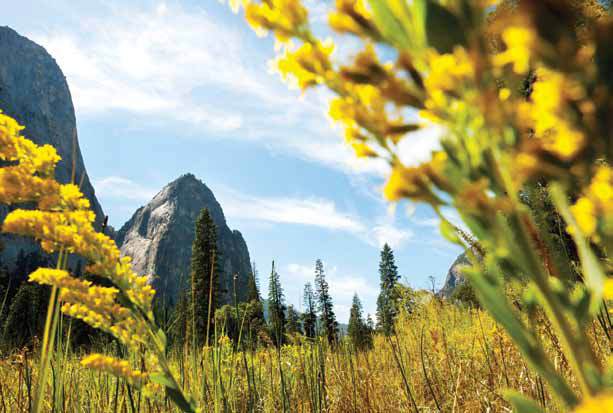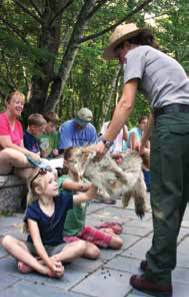Basic HTML Version





summer
2012
maskmatters.org
29
cobblestone bridges spanning streams,
waterfalls, cliffs and lookout points along
the way. To get off the beaten track, hike or
bike along the park’s 125 miles of historic
trails, surrounded by nature’s splendor.
For some seaside fun, claim your spot
on Sand Beach. Only 290 yards long, the
beach is mostly made up of sand made
from shell fragments that have been
crushed by the pounding surf. If you’re
brave enough to take a dip, be prepared
for an exhilarating swim. Summer water
temperatures only reach about 55 degrees.
Sand Beach also provides access to
Thunder Hole, where—if the timing
is right—visitors can experience the
unbridled power of the sea. When the
ocean current is strong, breaking waves
race into a narrow cleft in the shoreline
rocks, resulting in a loud booming
sound and sending cascades of spray
shooting as high as 40 feet into the air.
Biscayne national Park
Located on the southeastern Atlantic
coast of Florida near Miami, Biscayne is
an oasis of aquamarine waters, beautiful
islands and coral reefs teeming with
fish and plant life. With 95 percent of
its 172,000 acres found underwater,
the best way to experience the park
and its natural wonders is by boat.
Begin your tour at Convoy Point,
where the Dante Fascell Visitor
Center provides information about
the area, as well as services to arrange
guided tours, glass-bottom boat trips,
and canoe or kayak excursions.
Round out your trip to Biscayne
National Park with a visit to Boca
Chita Key, where a 65-foot ornamental
lighthouse built by Mark Honeywell,
one of the island’s former owners,
stands. Open to the public when park
staff or volunteers are on the island, the
p
(Above) A green sea turtle takes an underwater respite in the waters of Biscayne National Park.
(Top) Waterfall at Yosemite National Park.
PhoTogrAPhY
National Park Service/Ray Radigan, South Florida Caribbean Network; California Travel & Tourism Commission/Andreas Hub
take 5/
Tracks
& Trails
make your visit to your favorite
national park as easy and stress-free
as possible with these handy tips:
TickeT To ride
Fill up your gas tank before
arriving in the parks, where gas is
expensive, hard to find and sometimes
completely sold out. Conserve fuel
and avoid parking hassles by boarding
the free, eco-friendly park shuttles
wherever possible.
Have casH, will Travel
Bring plenty of cash, as some
in-park businesses won’t accept
credit cards and ATms are rare. exact
change helps pay for campsites,
wilderness permits and more.
THe rigHT sTuff
Pack all the outdoor gear
you’ll need. In-park stores don’t
always sell the right equipment
and the rentals may all be taken
by the time you arrive.
Hungry?
skip long lines at in-park cafeterias
and restaurants by packing a cooler
and a few grocery bags of food. make
sure your cooler isn’t so big that you
can’t store it safely in your vehicle or
in the bear-proof lockers, if provided.
ready, seT, acTion!
The best thing about visiting national
parks—especially in the summer—is
that many outdoor activities are free
and don’t require reservations. sign
up for a ranger-led nature walk or
campfire talk, or take part in unique
outings, such as boat trips, cycling
tours, stargazing and snorkeling.
Source: LonelyPlanet.com
28
maskmatters.org
summer
2012
on the
road
engage
✪
{
DID YOU KNOW?
}
Only 57 percent of Americans take all the vacation time they’re entitled to per year, which is usually only about two weeks.
AmericA
the Beautiful
story // michelle Jacoby
W
hile summer is a great time for families to explore new and
exotic places around the globe, some of the world’s most
beautiful treasures can be found right in our own backyard. With
397 national parks scattered from sea to shining sea, the United States is
blanketed with scenic destinations filled with nature’s beauty and adventure.
From the sea-kissed shores of Acadia National Park in Maine to
the granite cliffs and giant sequoia groves of Yosemite National Park in
northern California, visitors will not only get a glimpse into our country’s
stunning and diverse landscapes, but also learn about the area’s natural
resources, including native animals and plants, and its history and culture.
AcAdiA NAtioNAl PArk
From the pounding surf washing against the rocky shores to its stunning
peaks and vistas, Acadia is a veritable wonderland for nature lovers.The
47,000-acre park is home to a diverse population of plants, birds and animals,
as well as the highest peak on the U.S. Atlantic coast: Cadillac Mountain.
Begin your tour with a drive along Park Loop Road, a 20-mile route
that offers breathtaking views of the ocean, forests, lakes, rocky shores and
mountains.The main route (by car) through the park, it will take you over
p
(Above) ranger-led demonstration at Acadia
National Park. (Top) Brillant yellow meadow at
Yosemite National Park.

